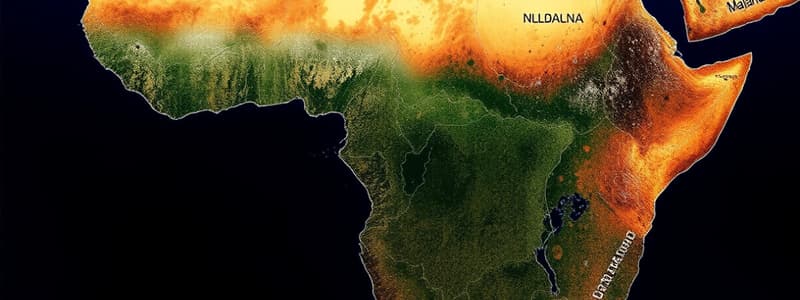Podcast
Questions and Answers
Describe the concept of a superimposed boundary.
Describe the concept of a superimposed boundary.
A boundary line or border line placed over and ignoring an existing cultural pattern or arbitrarily imposed by external powers.
Identify and explain one challenge landlocked African countries face in developing viable economies.
Identify and explain one challenge landlocked African countries face in developing viable economies.
Increased cost of imports due to customs, tariffs, tolls, distance, or transportation costs.
Describe three political or cultural consequences of superimposed boundaries in Africa.
Describe three political or cultural consequences of superimposed boundaries in Africa.
- Increased likelihood of religious, ethnic, or tribal conflict. 2. Increased likelihood of international, regional, or cross-border conflict. 3. Migration may increase the number of refugees or internally displaced persons (IDPs), disrupting traditional or seasonal migration patterns.
Explain two impacts of coffee farming on producing countries.
Explain two impacts of coffee farming on producing countries.
Identify and explain one way increased coffee consumption outside of coffee-growing areas affects its production.
Identify and explain one way increased coffee consumption outside of coffee-growing areas affects its production.
Describe a common characteristic shared by the coffee-producing countries shown on the map.
Describe a common characteristic shared by the coffee-producing countries shown on the map.
Explain one change in the urban landscape in the developed world associated with coffee consumption.
Explain one change in the urban landscape in the developed world associated with coffee consumption.
Flashcards are hidden until you start studying
Study Notes
Superimposed Boundaries
- Superimposed boundaries are lines established without regard to existing cultural or social patterns, often imposed by colonial powers.
- This practice has led to multiple internal and external conflicts in African nations, disrupting ethnic, religious, and tribal dynamics.
Challenges for Landlocked Countries
- Landlocked African nations face increased import costs due to customs fees, tariffs, toll charges, and greater transportation distances, hindering economic development.
Consequences of Superimposed Boundaries
- Internal Struggles: Heightened potential for civil conflicts arising from ethnic and tribal differences within imposed borders.
- External Conflicts: Greater likelihood of disputes between neighboring countries due to arbitrary border placements.
- Migration Issues: Disruption of traditional migration patterns can lead to an increase in refugees and internally displaced persons (IDPs).
Impacts of Coffee Farming
- Environmental Issues: Coffee production leads to negative environmental impacts, including soil erosion, deforestation, loss of biodiversity, and concerns related to agricultural chemical use and water consumption.
- Agricultural Land Use: The focus on cash crops like coffee limits the diversity of local agriculture, reducing food security and shifting practices from subsistence to commercial farming.
Global Coffee Consumption Effects
- Increased coffee consumption outside producing countries has prompted greater resource allocation toward coffee production, enhancing investment in land, technology, and labor.
- New production techniques are now being adopted, and profits are rising, inviting new entrants into the coffee industry.
Coffee Producing Regions
- Coffee-producing countries predominantly lie within tropical regions or along the tropic lines, often comprising former colonies situated at low latitudes and near the equator.
Urban Landscape Changes
- The rise in global coffee consumption has led to a surge in coffee shops in developed urban areas, spurred by factors like consumer convenience and central place theory.
- Significant changes include the strategic placement of coffee shops near high traffic areas such as malls, office buildings, and campuses, reflecting geographic theories of population distribution and service accessibility.
Studying That Suits You
Use AI to generate personalized quizzes and flashcards to suit your learning preferences.

